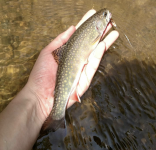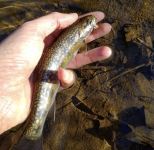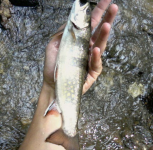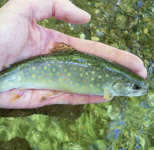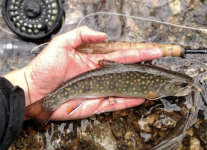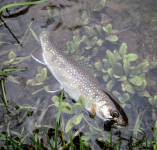Fish Sticks
Well-known member
Correct, what we are talking about is a spring fed spawning channel if we can make that project work up there as far as from a geotechnical/sediment transport perspective. The plan is to use the habitat evaluation programs HSI or habitat sustainability index to get habitat features (including right size and ratio of gravels for brook trout spawning) in the project. The spawning/nursery channel was designed to be a shallow area of thermal refuge/spawning habitat that might have a favorable effect in that one area on brown trout predation on age zero brook trout which is a very well documented concentration. That was thinking behind it. You generally want close by foraging habitat near your thermal refuge because Dr. Nathaniel hit showed brook trout travel shorter distances from thermal refuge to feed when brown trout present so we wanted the spawning channel to come out into and food rich riffle or glide rather than a deep plunge pool or ambush situation from a predation standpoint. If fishermen are interested in seeing final projects I can post pictures for the thread.
Your concerns are very valid Swattie, prevention is always better than mitigation. Removal is hard but not impossible, it has been done successfully before but you are right there are no doubt challenges. I share your wish to see brook trout preserved where browns have not infiltrated yet as well. The only concern I think that researchers would have about that is that the areas where that is the cases are very few and limited to above a few small impassible barriers in most cases. Most class A brook trout streams still have a small number of infiltrating browns when shocked it seems.
The reason this is a problem is at conservation genetics according to the STAC Chesapeake brook trout conservation genetics conference I recently attended, they mentioned that populations in these small isolated areas where browns cannot go are susceptible(likely already experiencing) inbreeding depression. This makes brook trout much smaller, less fertile, and less fit to survive and they eventually are extremely high risk to blink out. So the way it was explained to me is trying to only conserve brook trout in those situations is like putting all your money in one risky stock analogy wise.
Mark kirk ect Al. At Allegheny university found streams where barriers between brown trout stocking locations and brook trout were 12 times more likely to sustain brook trout. And he was trying to evaluate this trade off between isolation with these barrier situations and the ease off between invasion by brown trout. It’s my understanding that you want multiple streams above a barrier for like a little meta population to prevent inbreeding depression as much as possible. The only problem is the areas with a nice large network of tributaries that could increase population diversity mostly already have brown trout in them in my experience.
This is why at the STAC conference there was an entire presentation on super males (XYY fish) for removal. The thought is combination of removal above a barrier with multiple tributaries upstream containing different populations and also using genetic rescue to make larger, more fertile, more survivable brook trout aka reverse any inbreeding depression, above a barrier seems like a good way to mitigate isolation while reaping benefits of preventing future invasion.
I wouldn’t trust lay people like myself if I was in your guys situation either, I don’t blame you for being skeptical. It’s a very unnerving subject because we can all agree clean water and habitat are important but this is much diverse in how people feel. I will attach the link to the slide show from the STAC conference which was meeting between many brook trout genetics/ecology experts. It will help illustrate some of the concepts you may not hear from the commission in addition to the research I have posted in the snakeheads forum.
Look under presentations on this link and you can see experts like Dr.s Dave Kayzak, Shannon white, and Eric hallerman and many many more talking about YY super males, genetic rescue ect and giving management recommendations to PA fish and boat and others who were in attendance.

 www.chesapeake.org
www.chesapeake.org
Your concerns are very valid Swattie, prevention is always better than mitigation. Removal is hard but not impossible, it has been done successfully before but you are right there are no doubt challenges. I share your wish to see brook trout preserved where browns have not infiltrated yet as well. The only concern I think that researchers would have about that is that the areas where that is the cases are very few and limited to above a few small impassible barriers in most cases. Most class A brook trout streams still have a small number of infiltrating browns when shocked it seems.
The reason this is a problem is at conservation genetics according to the STAC Chesapeake brook trout conservation genetics conference I recently attended, they mentioned that populations in these small isolated areas where browns cannot go are susceptible(likely already experiencing) inbreeding depression. This makes brook trout much smaller, less fertile, and less fit to survive and they eventually are extremely high risk to blink out. So the way it was explained to me is trying to only conserve brook trout in those situations is like putting all your money in one risky stock analogy wise.
Mark kirk ect Al. At Allegheny university found streams where barriers between brown trout stocking locations and brook trout were 12 times more likely to sustain brook trout. And he was trying to evaluate this trade off between isolation with these barrier situations and the ease off between invasion by brown trout. It’s my understanding that you want multiple streams above a barrier for like a little meta population to prevent inbreeding depression as much as possible. The only problem is the areas with a nice large network of tributaries that could increase population diversity mostly already have brown trout in them in my experience.
This is why at the STAC conference there was an entire presentation on super males (XYY fish) for removal. The thought is combination of removal above a barrier with multiple tributaries upstream containing different populations and also using genetic rescue to make larger, more fertile, more survivable brook trout aka reverse any inbreeding depression, above a barrier seems like a good way to mitigate isolation while reaping benefits of preventing future invasion.
I wouldn’t trust lay people like myself if I was in your guys situation either, I don’t blame you for being skeptical. It’s a very unnerving subject because we can all agree clean water and habitat are important but this is much diverse in how people feel. I will attach the link to the slide show from the STAC conference which was meeting between many brook trout genetics/ecology experts. It will help illustrate some of the concepts you may not hear from the commission in addition to the research I have posted in the snakeheads forum.
Look under presentations on this link and you can see experts like Dr.s Dave Kayzak, Shannon white, and Eric hallerman and many many more talking about YY super males, genetic rescue ect and giving management recommendations to PA fish and boat and others who were in attendance.

Understanding Genetics for Successful Conservation and Restoration of Resilient Chesapeake Bay Brook Trout Populations
This page is used by Events Made Easy. Don't change it, don't use it in your menu's, don't delete it. Just make sure the EME setting called 'Events page' points to this page. EME uses this page to render any and all events, locations, bookings, maps, ... anything. If you do want to delete this

